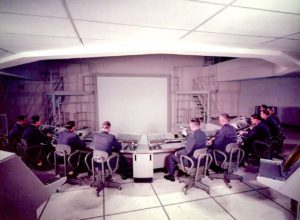SAGE, the Semi-Automatic Ground Environment Air Defense System began with an idea in 1951 and was fully deployed in 1963.
SAGE was operational from 1959 through 1984.
Why Am I Telling You About the SAGE System?
Well, truth is, it is sort of personal. I was in the United States Air Force (USAF) from mid-1958 until mid-1962. For almost three of those four years, I was a USAF instructor on how a subset of the SAGE equipment worked and how to fix it when there was a failure. The area where I instructed was fenced, with Air Police stationed at each gate, and the information was classified as Top Secret.
One more thing. It’s pretty darned interesting.
Why Was SAGE Developed?
The Soviet Union detonated their first atomic bomb on August 29, 1949. That action forced the United States government to realize that it needed a real-time, state-of-the-art air defense system.
How Much Did SAGE Cost?
SAGE cost over $10 billion, which is more than $100 billion in 2022 dollars.
To give a comparison of the enormity of the expense, the Manhattan Project cost was $2 billion, which is about $33.7 billion in 2022 dollars.
In other words, the cost of SAGE was three times the cost of the Manhattan Project.
Equipment
Electronic-wise, the original SAGE equipment was ancient. The main computers and all lower-level electronic equipment used vacuum tubes.
IBM provided some of the largest vacuum tube computers ever built. The floor space for one computer installation was huge; multi-story buildings were required and, because of the vacuum tubes, the air conditioning requirements were extremely high.
Just to keep those huge vacuum tube computers operational, IBM had 7,000 employees on the job. There were also USAF technicians.
For other electronics and RADAR, the primary technical staff was USAF technicians.
Duplex Operation
For all electronic equipment, the installations were duplex. That is to say, for any computer installation, large or small, there were two computers; one Active and one Standby. If there were an Active failure, the Standby would immediately become Active. The repaired Active would then be the Standby.
As an aside, I feel quite sure that, over time, vacuum tubes were replaced with transistors. But I really don’t know.
SAGE In a Nutshell
SAGE computers allowed USAF to be aware of all aircraft approaching our borders. The SAGE main computers were also fed flight information of all friendly aircraft. Any aircraft not verified as friendly would have missiles aimed at them in seconds, and be approached by USAF fighter aircraft in very few minutes.
Every inch of our border was covered by RADAR that fed its information into a very small computer which translated the RADAR data into digital data which was then transmitted to a main central computer.
By the way, the very small computer and the RADAR were the first-contact devices on which I was an instructor.
On our borders there were small USAF land bases where the first-contact SAGE equipment was located. There were also bases on Greenland and Iceland. The Canadian Air Force manned bases across Canada.
These northern USAF and Canadian bases were considered crucial because of the vast Arctic area. There was a very reasonable fear that the Soviets would attack from across the Arctic Circle.
Protecting our coastal borders there were also US Navy picket ships and fixed first-contact SAGE installations out at sea, which were called Texas Towers.
The sum of those SAGE installations was called the Distant Early Warning Line, or DEW Line.
Did It Do the Job?
I would say, “Yes.” I say that because for the entirety of SAGE’s operational life, 25 years, Soviet aircraft never attempted a penetration of our airspace.
Some may say, “Maybe they didn’t want to start a war.” I can only respond by saying, “You may think differently if you lived in those times.”
In other words, I think SAGE was money well-spent.
What Else Can I Say?
Truth be told, not much more to say unless you wish page after page of historical and technical stuff.
Google “SAGE Air Defense System”. You can find a lot without getting very technical, and there are some great videos.





